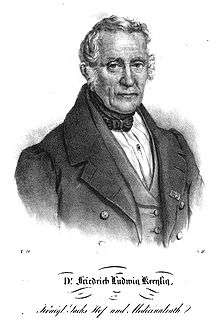Friedrich Ludwig Kreysig

Friedrich Ludwig Kreysig (7 July 1770 – 4 June 1839) was a German physician born in Eilenburg.
In 1795 he received his medical doctorate from the University of Leipzig, and during the following year served as a substitute to Johann Gottfried Leonhardi (1746–1823) at the University of Wittenberg. In 1801 he became a professor of anatomy and botany at Wittenberg.[1]
In 1803 he was appointed personal physician to Frederick Augustus, and from 1815 served in Dresden as a trainer of Saxon military doctors. Due to health reasons, he left academic work in 1822, retiring to a private practice, from which he concentrated on botanical studies.
Kreysig is largely known for his work with cardiological diseases. In 1815 he explained inflammatory processes associated with endocarditis.[2] With physician Ernst Ludwig Heim (1747–1834), the "Heim-Kreysig sign" is named, which in adherent pericardium, an in-drawing of the intercostal space occurs, synchronous with the cardiac systole.[3]
In 1828, he was elected a foreign member of the Royal Swedish Academy of Sciences.
Kreysig died in Dresden.
Selected written works
- Aristotelis de soni ed vocis humanae natura atque ortu theoria cum recentiorum decretis comparata, Leipzig 1793
- De peripneumonia nervosa s. maligna commentatio, Leipzig 1796
- Neue Darstellung der physiologischen und pathologischen Grundlehren (New representation of physiological and pathological basic teachings), Leipzig 1798–1800
- Abhandlung über das Scharlachfieber, nebst Beschreibung einer sehr bösartigen epidemischen Frieselkrankheit, welche im Februar 1801 in Wittenberg herrschte (Essay on scarlet fever, etc.), Leipzig 1802
- Die Krankheiten des Herzens, systematisch bearbeitet und durch eigenen Beobachtungen erläutert (Diseases of the heart, etc.), Berlin (1814–1817, four volumes)
- System der praktischen Heilkunde, usw (System of Practical Medicine); Leipzig und Altenburg, (1818–1819, two volumes)
- Über den Gebrauch der Mineralwässer von Karlsbad, Ems, usw (On the usage of mineral waters of Karlsbad, Ems, etc.), Leipzig 1825
References
- "Parts of this article are based on a translation of text from an equivalent article at the German Wikipedia".
- ↑ ADB:Kreysig, Friedrich Ludwig at Allgemeine Deutsche Biographie
- ↑ CDC Emerging Issues in Infective Endocarditis
- ↑ Mondofacto Dictionary definition of eponym
|